This week we’re tackling a subject many of my readers write to me about, expressly delivery vehicles. Nowadays, things have changed drastically as the boom in online shopping has resulted in a new phenomenon, namely Amazon Prime delivery vans appearing daily on our streets everywhere in America.
These company specific Amazon Prime vans join the usual delivery services; specifically USPS, UPS and DHL all finished in its company specific color regalia. The more consumers order online, the more we’ll undergo the demise of the brick-and-mortar stores, including indoor / outdoor malls and shopping centers.
It’s a sad ending for what was once our beloved gathering place for everything from movies, dinner, shopping, and most important camaraderie. Bottom line? You can’t stop the power of ordering online and having the product sitting on your doorstep the next day.
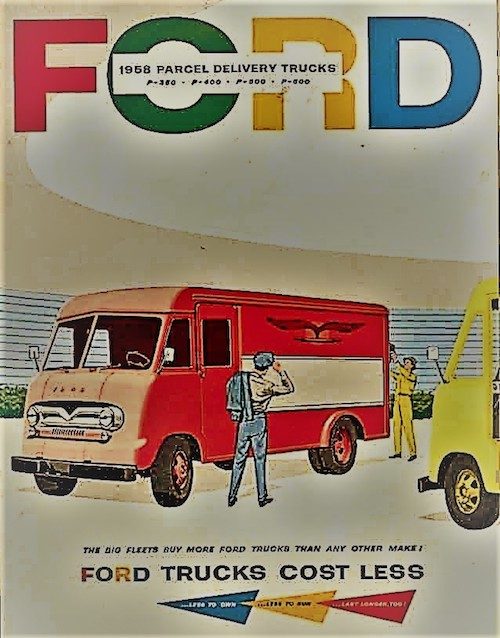
The 1958 Ford Parcel Delivery was a heavy-duty workhorse that came in four different styles from P-350 to P-600 strengths with dual rear wheels/tires and multi-lug heavy-duty wheels. (Ford)
However, things were different in yesteryear when deliveries usually went to businesses, both small and large, in specially produced delivery vehicles. Sure, there was limited mail order around, but in person trips for shopping were still the preference.
Further, in addition to the Prime delivery vans, which I see go up and down my street daily here in Sayre, Pa., I recently noticed what I thought was a food delivery service in my driveway like Uber Eats, DoorDash, Postmates, Grubhub, and Toast Takeout, but it turned out to be an independent Amazon delivery driver using her own SUV instead of the larger Prime Amazon grey colored van. This realization means Amazon is growing to now include independent drivers like Uber and DoorDash.
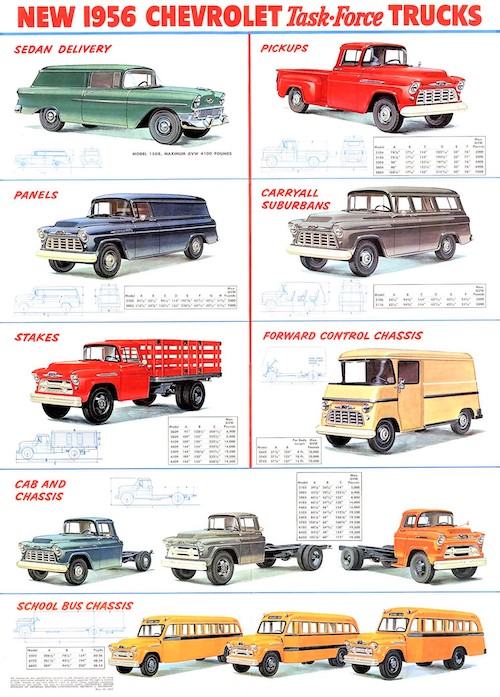
The 1956 Chevrolet Task Force Truck advertisement explains its truck models in detail, from sedan delivery to school bus. (Chevrolet)
However, back in 1955 things were different. I remember watching my dad hand lettering a new 1955 Chevy Panel Delivery Wagon for a local business. The car/truck was black with shiny hubcaps and my dad used a high gloss yellow paint to “letter” the company name, address and phone number on the side and doors.
With this vivid memory still playing in my mind, (and yes, I’ve written about the experience before) I’m sure we agree that here in 2023 the popularity of all types of collectable trucks are still growing tremendously and proven by the money these early day vehicles generate at Mecum and Barrett-Jackson auctions. Even stripped-down pickups, known as farm trucks, are commanding $30,000 and up in great, restored condition
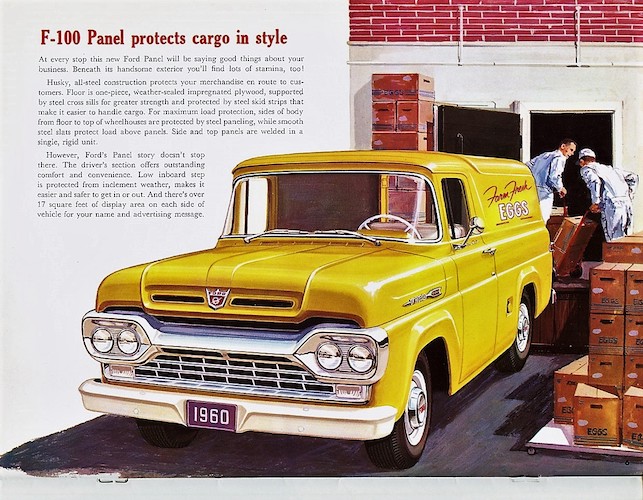
Ford’s 1960 F-100 series delivery truck was a best seller and used by many companies for deliveries. (Ford)
As for the collector’s love of panel trucks from 1957 to 1960, the most popular back then were the Chevy / GMC and Ford varieties with Dodge, International, and Studebaker also notable. These panel and smaller delivery trucks were extremely popular; back then the smaller vans that would eventually replace the car-like delivery panels that were just starting to arrive on the scene. From Charles Chips to Tastykake vans, the streets were advertising venues for the hundreds of companies that understood the importance of a rolling billboard.
And, just as the full-size delivery vans that were then the number one choice of many companies (like the 1960 F-100 Series Fords), they would also share some lighter duty hauling with the smaller, car-like station wagon sedan delivery units that popped up quickly. In 1960, even the new compact Ford Falcon delivery panel joined the fray while competing Corvair offered a van and pickup truck, both rear engine vehicles.
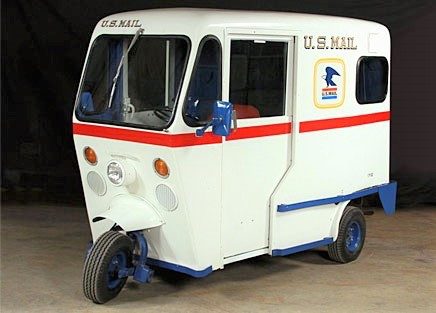
The Mailster, a three-wheel mail delivery vehicle, was produced from 1957 to 1963. The vehicle wasn’t popular with the mail carriers as it was prone to poor handling and mechanical damage. (Smithsonian National Postal Museum)
Not surprisingly, these panel delivery trucks, from full size to compact, were similar in that they were built with no seating other than the driver, and in some instances a passenger seat. Likewise, the station wagons were quickly turned into delivery wagons by removing the side windows and rear seating. By the early 1970s, even the Chevy Vega and Ford Pinto offered panel wagons that to this day are popular, lower cost entries into the world of collectible trucks.
Next arrived the now defunct Chevrolet HHR (high heritage roof) and Chrysler PT Cruiser conversions, which were both created by noted car designer Bryan Nesbitt. These little car / wagons became instant hits when retrofitted in sedan delivery livery and were used by countless companies for light duty deliveries.
Additionally, the original delivery panel trucks I’ve written about since back in 1974 did have competition as Chevy, Ford and Willys come quickly to mind. However, unlike the light duty Metro, I remember the heavy-duty Ford Delivery vans that came in P350 to P600 series builds with dual rear wheels and heavier load capability.
The attached 1956 Chevrolet Task Force Truck advertisement best exemplifies how the major manufacturers promoted their truck line. Everything from light duty panels to the bigger delivery trucks is clearly explained in detail, including haul abilities and cargo information.

The Jeep was a popular USPS mail truck, especially in inclement weather climates. Jeeps were used until production of the LLV took over in the late 1980s. However, in rural areas, the Jeep Cherokee 4×4 lasted until 2001. (Jeep)
In summary, sedan deliveries and delivery panel trucks came in all shapes and sizes, from the converted station wagons (even the Studebaker Lark had one in 1960) to the big bruisers from Chevy, Dodge and Ford that were common sights on our nation’s highways. Unfortunately, you just don’t see that many anymore these days.
At this point, let’s dig into some reader letters on mail delivery vehicles. Further, I’m nearly finished on my fourth installment of the Top 10 Muscle Cars of all-time.
Haulin’ the mail, rain or shine
Q: I enjoy reading your articles on the history of the postal vans that I find online. However, a small piece of history is missing, namely the 1963-1964 Studebaker Zip Van, which was surprisingly similar to the LLV (Long Life Van by Grumman) in design.
As a fan of Studebaker, I couldn’t let this slip by. I had a chance to drive a restored Studebaker USPS delivery van, and it seemed well built and performed well. Obviously as with most of the Studebaker line they were ahead of their time, ala the 1908 Studebaker Electric Truck and the 1902 Studebaker Electric Passenger Car.
The Studebaker delivery vans were the last trucks to be produced by the brand as Studebaker built these especially for the US Postal Service. Frank Murtinger, Minneapolis, Minnesota.
A: Thanks for the info, Frank. I have many Studebaker car and truck fans that will appreciate this historical information.
How about a three-wheeler mail truck?
Q: Greg, was there ever a motorcycle style three-wheel mail delivery vehicle? My retired friends here in Florida say they remember seeing them in the cities. Charles B., Jacksonville, Florida.
A: Yes Charles, and it was called the Mailster. This three-wheeler weighed only 500 pounds, had a 7.5-horsepower motorcycle style engine, and allowed each delivery person to haul up to 500 pounds of mail. Mailster’s compact size and maneuverability were ideal for getting around suburban areas and cities, and by the end of the 1950-decade one-third of the USPS fleet was made up of this vehicle.
Turns out that even though the higher-up USPS corporate types were more enthusiastic about the Mailster’s potential, the postal employees delivering mail on the Mailster hated them, according to Nancy Pope of the Smithsonian National Postal Museum.
Complaints from letter carriers assigned to Mailsters ranged from the front wheel getting stuck in trolley tracks to constant breakdowns, Pope says, and even one report of a massive dog toppling the vehicle.
After many complaints and malfunctions, the postal service opted for the more reliable and sturdy Jeep to replace the Mailster as the centerpiece of its fleet. The Jeep continued its dominance of the USPS fleet until the late 1980s when they were replaced by the mail delivery van we came to know.
(Greg Zyla is a syndicated auto columnist who welcomes reader interaction on motoring nostalgia, collector cars or motorsports at greg@gregzyla.com or at 303 Roosevelt St., Sayre, Pa. 18840).

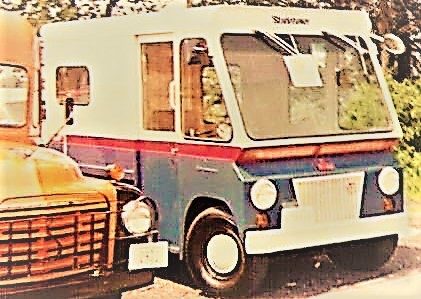

Be the first to comment on "Collector Car/Cars We Remember; Delivery trucks: from Amazon Prime to the USPS Mail Delivery Vans"